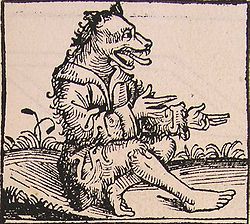Here is yet another monstrous race-as-class for OSE. This one covers the mythical Astomi – a race of monstrous humans who were physically imposing and had no mouth. It is said that they would feed themselves on odours alone, and could only be killed by a particularly pungent smell.
I like the challenge of making this sort of creature into a class, as it provides a set of very clear drawbacks to try to play around, and I as a designer need to figure out what would make it “worth it” to play the class without making it overpowered or just plain crap. This time, I’ve given the Astomi some natural AC, which whilst rarely as good as Plate mail, has the double benefit of not taking up room in the inventory.

Astomi Class
Very few Astomi exist, and those that do tend to shun civilised, urban centres, deeming them too pungent for their sensitive noses. Physically imposing, the Astomi stand over 7 feet tall and are covered head to toe with thick, porcupine like spines, providing them with a natural means of defending themselves. Astomi have no mouths, and as such sustain themselves by smelling things with nice odours – whatever they smell withers away and cannot be smelled again, but a particularly nice flower will sustain them for an entire day. A particularly pungent smell is likely to cause harm to the Astomi and causes damage to them if exposed to it for too long.
Requirement: Minimum CON 13
Prime Requisite: CON
Hit dice: d8
Maximum level: 9
Armour: None, Shields
Weapon: All weapons
Languages: Can understand but not speak Common, Alignment language
Combat
Astomi cannot wear armour, however their thick coat of spines provides a natural form of defence. Their AC bonus is equivalent to their CON modifier *2. For example, an Astomi with a CON of 13 would have a CON modifier of +1, giving them +2AC to a total of 12 AC.
Astomi can wield any weapon, and because of their large physical size add +1 to their damage rolls.
I have no mouth, but I must breathe
Astomi have no mouths, and as such sustain themselves by smelling things with nice odours – whatever they smell withers away and cannot be smelled again. A particularly pungent smell is likely to cause harm to the Astomi and causes damage to them if exposed to it for too long. If the Astomi is in an enclosed area with a pungent, disgusting smell for more than one turn, they take 1d4 damage per turn.
Keen smell
However, their keen sense of smell can prove to be a powerful boon within a dungeon - giving them a 2-in-6 chance to smell things from up to 2 rooms away if they spend 10 minutes focussing on the odours of the dungeon.
Level | XP | HD | THAC0 | D | W | P | B | S |
1 | 2,000 | 1d8 | 19[0] | 8 | 9 | 8 | 10 | 12 |
2 | 4,000 | 2d8 | 19[0] | 8 | 9 | 8 | 10 | 12 |
3 | 8,000 | 3d8 | 19[0] | 8 | 9 | 8 | 10 | 12 |
4 | 16,000 | 4d8 | 17[+2] | 6 | 7 | 6 | 8 | 10 |
5 | 32,000 | 5d8 | 17[+2] | 6 | 7 | 6 | 8 | 10 |
6 | 64,000 | 6d8 | 17[+2] | 6 | 7 | 6 | 8 | 10 |
7 | 128,000 | 7d8 | 14[+5] | 4 | 5 | 4 | 6 | 8 |
8 | 256,000 | 8d8 | 14[+5] | 4 | 5 | 4 | 6 | 8 |
9 | 512,000 | 9d8 | 14[+4] | 4 | 5 | 4 | 7 | 8 |


